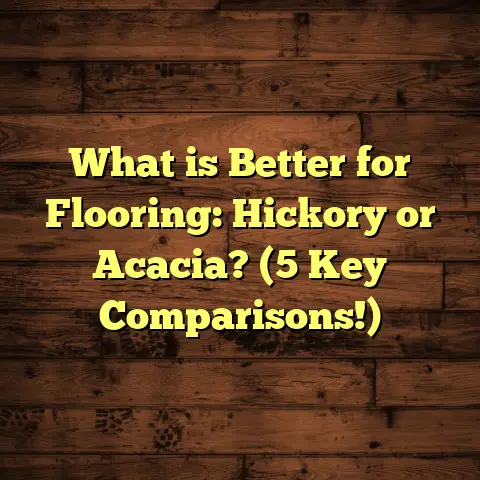What is Floating Installation for Flooring? (5 Key Benefits Explained)
When I first got into flooring work, I quickly realized one thing homeowners care about more than anything else: resale value. It’s not just about making a house look good while you live in it; it’s about making sure your investment pays off when you decide to sell. Flooring plays a huge role in this. A beautiful floor can catch a buyer’s eye immediately and add thousands of dollars to a home’s market price. On the other hand, outdated, damaged, or cheaply installed flooring can turn buyers away faster than you’d think.
Over the years, I’ve seen countless clients wrestle with which flooring type and installation method to choose. One approach that consistently pops up is something called floating installation—especially for laminate, engineered hardwood, and vinyl floors. But what exactly is floating installation? Why is it so popular, and does it really live up to the hype?
I want to share everything I’ve learned from hands-on experience, industry data, and research so you can make the best choice for your flooring project. Let’s start with the basics.
What is Floating Installation for Flooring?
You might hear people say “floating floors” and wonder what it means. Well, floating installation is a method where the floorboards or planks aren’t nailed or glued down to the subfloor beneath. Instead, they’re connected to each other—usually by a click-lock system or tongue-and-groove joints—and “float” above the subfloor.
Imagine laying down a giant puzzle on your floor, where each piece locks tightly to the next without being stuck down permanently. That’s basically how floating floors work.
The subfloor remains untouched by nails or glue, which gives the entire floor some natural flexibility. This flexibility helps the flooring expand and contract with changes in temperature and humidity without cracking or warping.
Floating floors are commonly used with laminate flooring, engineered hardwood, and certain types of vinyl plank flooring. The key here is that these types of flooring come with pre-attached locking systems that snap together easily.
Contrast this with traditional hardwood floors that are usually nailed or stapled down directly into plywood or concrete subfloors. With those, the boards are fixed in place permanently.
Floating floors rely on two main components:
- Interlocking planks that snap or click together tightly.
- An underlayment that sits under the floorboards to cushion them and provide moisture protection.
Because floating floors aren’t attached to the subfloor itself, they can be installed over many different surfaces—including concrete slabs, plywood, or even existing flooring—making them extremely versatile.
Now that you know what floating installation is, let me tell you why I think it’s worth considering for your next flooring project. Based on my years on the job and dozens of projects, here are five key benefits that stand out.
1. Easier and Faster Installation
One of the first things I noticed when working with floating floors was how much quicker they go down compared to traditional nailed or glued floors.
I remember helping install a laminate floating floor in a small office space early in my career. We finished in about half the time it would have taken with nailed hardwood planks. The process was simple:
- We laid down an underlayment (usually foam or cork).
- Then snapped each plank together using the click-lock system.
- No need to wait for glue to dry or hammer nails into the subfloor.
- The entire floor came together smoothly and securely.
This ease of installation is a massive benefit for both contractors and DIY enthusiasts.
Why is floating installation faster?
- No adhesives: No waiting around for glue to dry, which can take several hours.
- No nails or staples: Eliminates time spent hammering or using nail guns.
- Simple tools: You usually only need a saw to cut planks and a tapping block to lock them together.
- Versatile subfloor compatibility: Can be installed over many surfaces without prep work like removing old flooring.
- Less mess: No glue spills or nail holes to clean up afterward.
An industry report from Floor Covering Weekly found labor time for floating floor installs can be up to 40% less than traditional glue-down hardwood floors. That’s significant when you’re budgeting your project timeline and costs.
For homeowners wanting a weekend DIY project, floating floors are often the most manageable option. I’ve guided many first-timers through their installations over video calls or in person. Seeing their pride when they finish their own floor so quickly never gets old.
2. Cost-Effective Flooring Solution
If you ask me about budget-friendly flooring options that still look great and last long, floating floors often come out on top.
Why? Because floating floors save money in multiple ways:
- Lower labor costs: Faster installation means contractors charge less for labor.
- No need for expensive adhesives or fasteners: Saves materials cost.
- Can be installed over existing flooring: Avoids costly removal fees.
- Often use engineered wood or laminate: These materials generally cost less per square foot than solid hardwood.
Take a project I recently did at a family home: we installed a floating engineered hardwood floor over an old vinyl surface in their living room. The total cost came to about $6 per square foot including materials and labor. Comparable nailed-down hardwood would have been closer to $10+ per square foot because of prep work and longer install times.
According to HomeAdvisor data:
| Flooring Type | Average Cost per Sq Ft (Materials + Labor) |
|---|---|
| Laminate Floating Floor | $3 – $7 |
| Engineered Hardwood | $4 – $9 |
| Solid Hardwood (Nailed) | $8 – $14 |
That means floating floors can make hardwood-look finishes accessible even if your budget isn’t huge.
For folks wanting a quality floor without stretching finances too thin, floating installation paired with laminate or engineered wood is a smart pick.
3. Exceptional Durability and Stability
Something I hear often is people worrying that “floating” means “flimsy.” But in my experience, floating floors are anything but fragile.
The interlocking click-lock system creates a tight bond between planks that distributes weight evenly across the surface. This makes the floor very stable underfoot.
I recall a project where we installed laminate floating flooring in a busy kitchen used by a family with three kids and two dogs. After two years of heavy foot traffic, spills, and dropped pans, the floor still looked great — no gaps, no warping.
Here’s why floating floors hold up well:
- The planks are engineered with wear layers and protective coatings that resist scratches and stains.
- The slight flexibility allows natural expansion without cracking.
- The underlayment cushions impacts which helps prevent damage.
- They resist dents better than solid hardwood in many cases.
According to the National Wood Flooring Association (NWFA), high-quality laminate and engineered wood floors installed using floating methods can last 15-25 years with proper care — very comparable to traditional nailed-down hardwood.
During my years working on commercial spaces like offices and retail stores using floating vinyl plank floors, I’ve seen them withstand thousands of footsteps daily without showing wear for over a decade.
If durability is important but you want something easier on your wallet than solid hardwood, floating floors are tough contenders.
4. Better Moisture Resistance Compared to Traditional Hardwood
Moisture is one of the biggest enemies of hardwood floors. I’ve witnessed plenty of nailed-down hardwood ruined by water leaks or humidity changes causing warping and buckling.
Floating installation offers some advantages in moisture resistance:
- Because the boards aren’t glued or nailed directly to the subfloor, moisture trapped below has less chance of causing damage.
- Most floating floors feature an underlayment with built-in moisture barriers (like plastic films).
- The floor has expansion gaps around edges allowing moisture-related swelling without buckling.
- Some vinyl plank floating floors are even waterproof or water-resistant.
A recent basement remodeling project comes to mind. The homeowner had concerns about dampness from their concrete slab foundation. We chose waterproof vinyl plank flooring installed as a floating floor over a moisture barrier underlayment. After several minor water leaks over two years, there was no sign of damage—no warping or mold growth.
Research from the Resilient Floor Covering Institute shows that moisture barriers used beneath floating floors reduce failures caused by moisture by as much as 50%.
If you live in humid regions or want durable floors for kitchens, bathrooms, basements, or mudrooms, floating floors give you an edge in handling moisture better than traditional nailed-down hardwood.
5. Easy Repairs and Replacement
Here’s something I’ve personally appreciated about floating floors: repairs are simpler than with other kinds of floors.
With nailed or glued hardwood floors, fixing damage means sanding down large sections or even tearing up whole rooms sometimes. That’s stressful and expensive.
But because floating floors come apart plank by plank:
- You can remove individual damaged planks easily without disturbing neighbors.
- No glue residue or nail holes to fix afterwards.
- Replacement planks are often sold individually for spot repairs.
- Repairs are faster and less disruptive.
Once, a client called me after their dog scratched several planks on their laminate floating floor. We popped out just those boards and swapped them for new ones in under an hour — no mess or fuss.
This modularity keeps your floor looking fresh much longer since small accidents don’t turn into full replacements.
Deeper Insights: Why Floating Floors Are Changing Flooring Choices
You might ask yourself why floating installation has gained so much traction in recent years across residential and commercial projects.
Here’s what I’ve learned from talking with other contractors and studying market trends:
Growing Popularity of Engineered Wood & Laminate
The rise of engineered hardwoods and laminates designed specifically for floating installation has made this method more accessible and attractive. These materials combine durability with natural looks at lower prices than solid hardwoods.
Demand for DIY Solutions
More homeowners want to tackle home improvements themselves nowadays. Floating installation fits this desire perfectly because it’s straightforward without heavy equipment or special skills required.
Environmental Considerations
Floating floors often use less raw wood since engineered products layer thinner wood veneers over plywood cores. This makes them more sustainable choices compared to solid hardwoods harvested from old forests.
Flexibility & Reversibility
Because floating floors aren’t permanently attached, they can be removed later with less damage—ideal for renters or people who move frequently who want stylish but temporary flooring solutions.
Personal Stories from My Worksite
Let me share some stories from my own experience that highlight these benefits in action:
Story 1: The Kitchen Makeover That Saved Time & Money
A couple hired me to redo their kitchen floor quickly before hosting family for Christmas. They wanted a beautiful wood look but couldn’t wait weeks for traditional hardwood glue-down installation.
We chose an engineered hardwood floating floor with click-lock planks installed over their old tile floor. Installation took only three days total instead of one week plus drying time for glue.
They were thrilled — not only did it look fantastic but they saved nearly $2,000 on labor alone!
Story 2: Fixing Flood Damage Without Stress
After a pipe burst flooded part of a basement laundry room, the homeowner was worried about having to replace expensive hardwood nailed floors throughout their house.
We recommended waterproof vinyl planks installed as floating floors in that area. Months later after minor flooding issues recurred, those areas stayed intact while other parts of their house needed more repairs.
They appreciated how easy cleanup and replacement were thanks to the floating design.
What You Should Know Before Choosing Floating Installation
While I’m enthusiastic about floating floors, not every situation is perfect for them. Here’s what I advise considering:
Subfloor Condition Matters
Floating floors require flat subfloors free from bumps or dips over 3/16 inch across 10 feet. Uneven surfaces can cause creaking or gaps later on. You may need to level your subfloor first which adds cost/time.
Expansion Gaps Are Critical
You must leave proper expansion gaps around room edges (usually 1/4 inch) to allow movement. Improper spacing leads to buckling as boards push against walls when expanding.
Sound & Feel Differences
Floating floors sometimes feel slightly “springy” compared to nailed hardwood which feels more solid underfoot. Also, laminate can sound hollow if not paired with good underlayment.
Not Ideal for Every Style
Some traditionalists prefer the look and feel of solid hardwood nailed down—especially older homes where historical accuracy matters.
Final Thoughts: Is Floating Installation Right For You?
From my years working directly with clients on residential renovations and commercial projects alike, floating installation offers huge benefits if you want:
- Faster installs saving time & labor,
- Budget-friendly costs,
- Durable performance,
- Resistance against moisture problems,
- And easy maintenance/repairs,
all wrapped up in an attractive package suitable for many spaces from basements to kitchens to living rooms.
If you’re shopping for new flooring options right now, give serious thought to trying out floating installation with laminate, engineered wood, or vinyl plank products tailored for this method.
They may just be the perfect fit that balances style, function, and value — helping you boost your home’s desirability today while protecting your investment for tomorrow’s resale market.
Got questions about specific brands? Need help planning your install? Or curious about how floating flooring compares with other options like glue-down vinyl or nailed hardwood? Just ask—I’m always happy to share what I’ve learned from decades on the job!
Have you tried floating floors yourself? What was your experience? Share your stories below—let’s keep this conversation going!
Quick Recap: 5 Key Benefits of Floating Installation
| Benefit | Why It Matters |
|---|---|
| Easier/Faster Installation | Less labor/time; DIY-friendly |
| Cost-Effective | Saves money on materials & labor |
| Durability & Stability | Long-lasting; withstands wear & tear |
| Better Moisture Resistance | Protects against warping & damage |
| Easy Repairs & Replacement | Spot fixes possible; less disruption |
I hope this detailed guide helps you feel confident about what floating installation means and how it could work well in your home or business flooring project!
If you want, I can also recommend some trusted brands or walk you through estimating costs using tools like FloorTally — just let me know!





